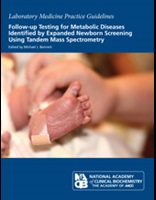The National Academy of Clinical Biochemistry
Laboratory Medicine Practice Guidelines
Follow-Up Testing for Metabolic Diseases Identified by Expanded Newborn Screening Using Tandem Mass Spectrometry
Publication Date: 2008
At the time of publication of this document, approximately 98% of all babies born in the United States are provided with expanded newborn screening for metabolic diseases by tandem mass spectrometry. The increased numbers of different metabolic diseases that are identifiable by tandem mass spectrometry also increases the complexity of testing required for confirmation of diagnosis. Confirmatory testing is a critical component of the whole process, which may involve additional metabolite measurement, enzyme assay, or molecular testing. We recognize the importance of establishing guidelines for systematic, consistent, and appropriate disease confirmation in the clinical laboratory and also guidelines for monitoring efficacy of therapeutic intervention and patient well-being. MCAD deficiency is now mandated in 46 states and the District of Columbia, required but not yet implemented in one state, and offered but not mandated in two additional states. It is highly likely that the process will be taken up by the few remaining states or other providers will provide the service for MCAD deficiency for all babies born in those states before the end of the present decade. In addition, tandem mass spectrometry is being utilized for multiple additional metabolic conditions, which vary by state. NACB recognizes that there is a strong need for evaluation of how these newborn screening laboratory services are provided, and of equal importance, how procedures for adequate follow-up testing should proceed.
The recommendations contained herein are based upon the best available evidence and consensus of expert contributors and reviewers. Toward this effort, draft revisions of these guidelines were prepared and placed for comment on the NACB web site. The guideline chapters resulting from this process have been published in appropriate peer-reviewed laboratory medicine and specialty clinical journals to assist with dissemination among the target groups. This LMPG was presented at the AACC Annual Meeting, July 15-19, 2007, Chicago, IL; at the Pediatric Academic Societies Annual Meeting, May 3-6, 2008, Honolulu, HI; at the International Association for Pediatric Laboratory Medicine Meeting, September 26-28. 2008, Fortaleza, Brazil; and in part at the Association for Clinical Biochemistry Meeting, May 18-19, 2008, Birmingham, United Kingdom; and the Brazilian Society for Clinical Laboratory Medicine Meeting, 2008, Sao Paulo, Brazil.
Guidelines Committee
- Michael J. Bennett, PhD, FRCPath, FACB, Chair, University of Pennsylvania and Children’s Hospital of Philadelphia, PA, USA
- Piero Rinaldo, MD, PhD, FACMG, Mayo Clinic, Rochester, MN, USA
- Ronald J.Whitley, PhD, FACB, University of Kentucky Medical Center, Lexington, KY, USA
- William J. Rhead, MD, PhD, FACMG, Medical College of Wisconsin and Children’s Hospital of Wisconsin, Milwaukee, WI, USA
- W. Harry Hannon, PhD, Centers for Disease Control and Prevention, Atlanta, GA, USA
- Dennis J. Dietzen, PhD, FACB, Washington University and St Louis Children’s Hospital, St Louis, MO, USA
- Uttam C. Garg, PhD, FACB, University of Missouri, Kansas City School of Medicine and Children’s Mercy Hospital, Kansas City, MO, USA
- Stanley F. Lo, PhD, FACB, Medical College of Wisconsin and Children’s Hospital of Wisconsin, Milwaukee, WI, USA
This LMPG was developed by an independent committee of the NACB. Subsequent publication of these guidelines has been supported by the Academy.
Author Disclosures